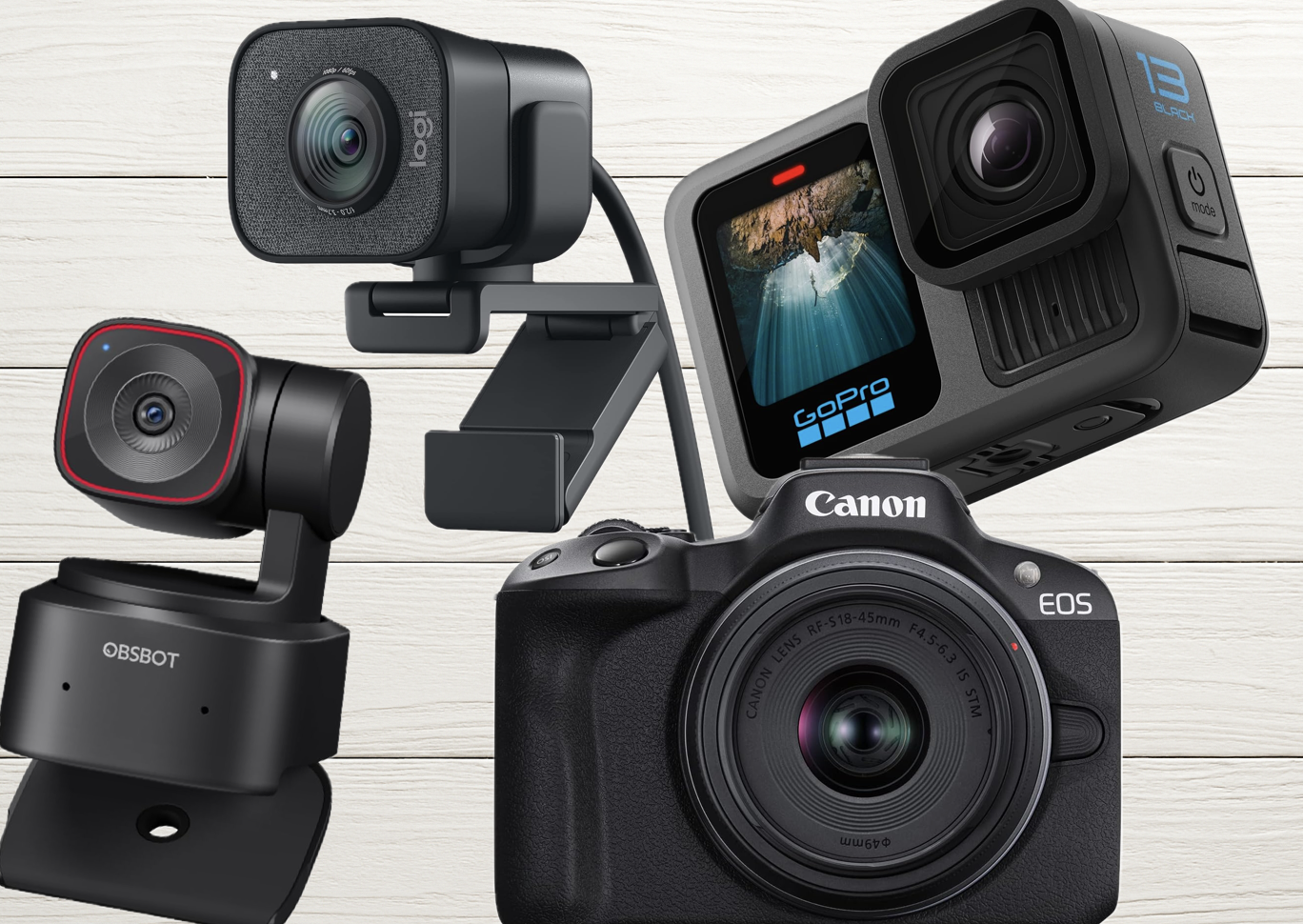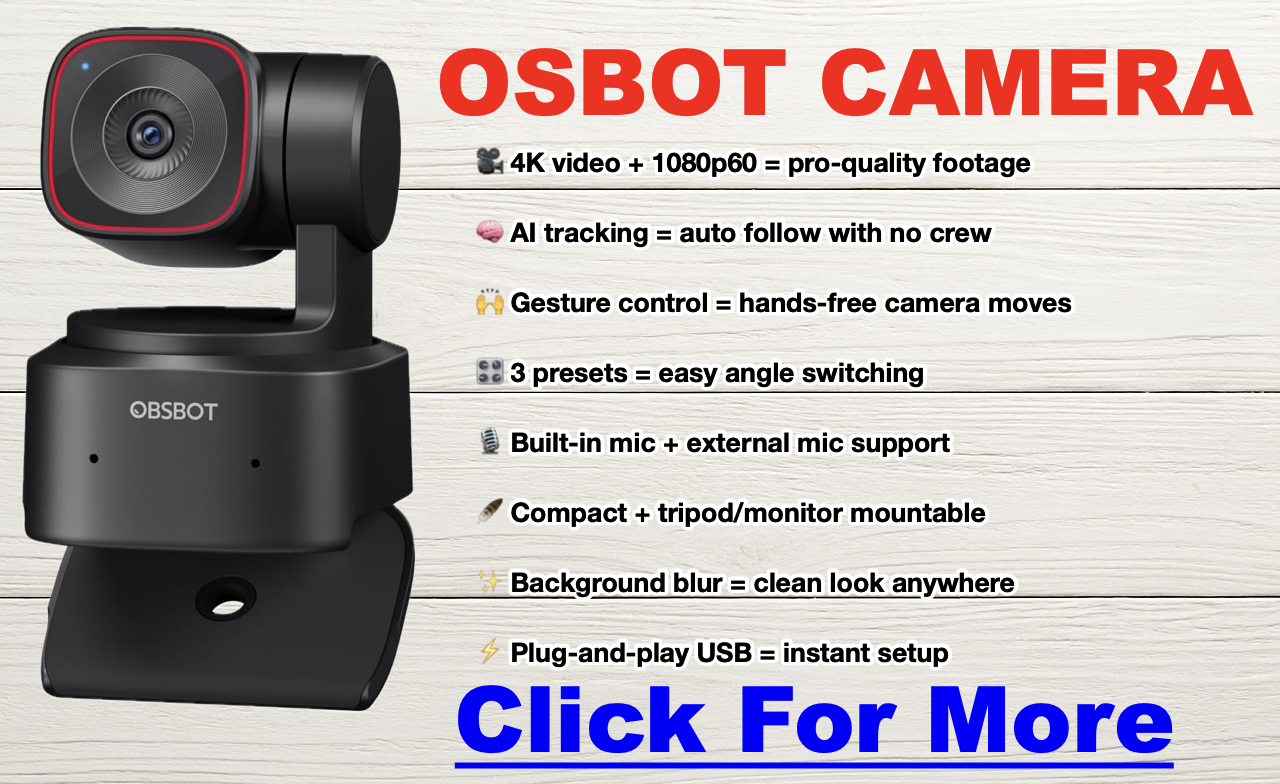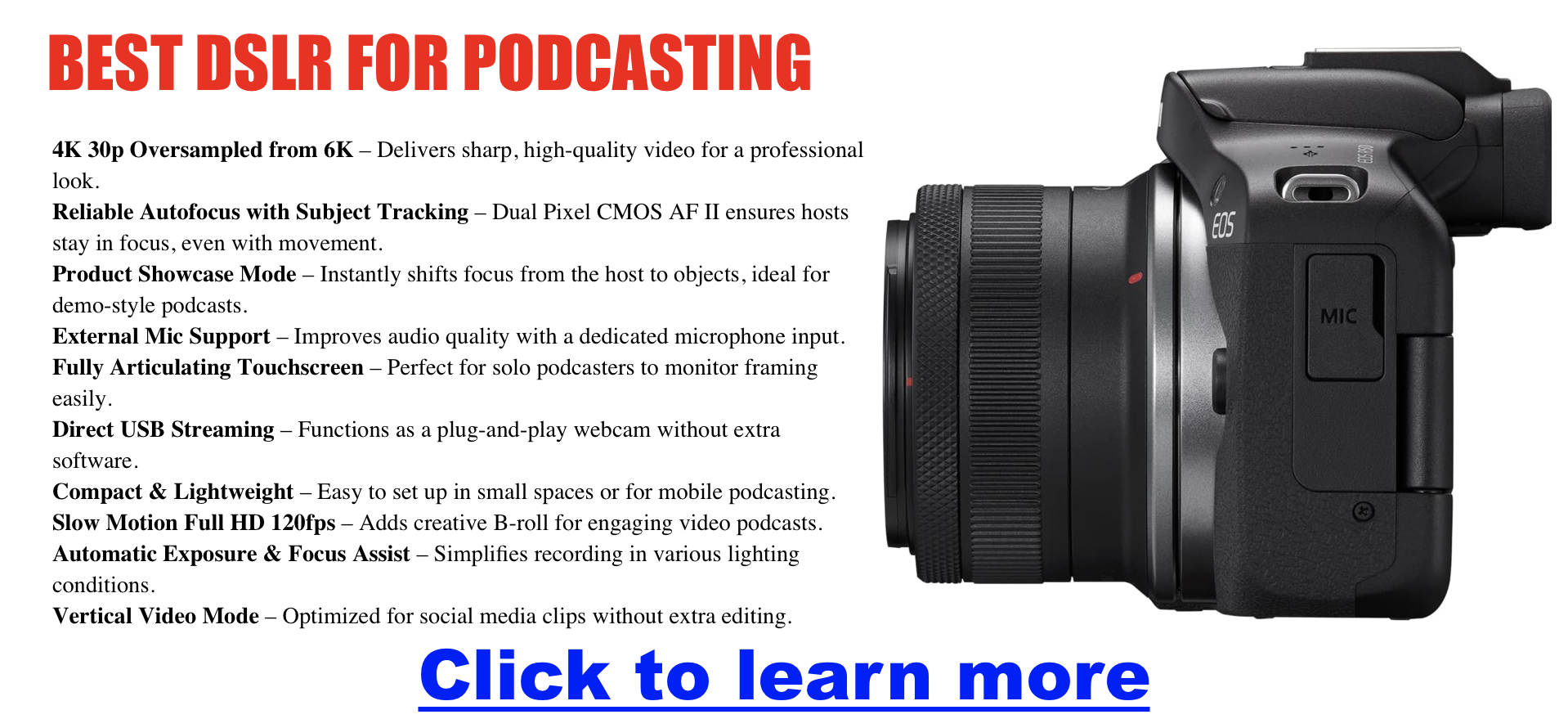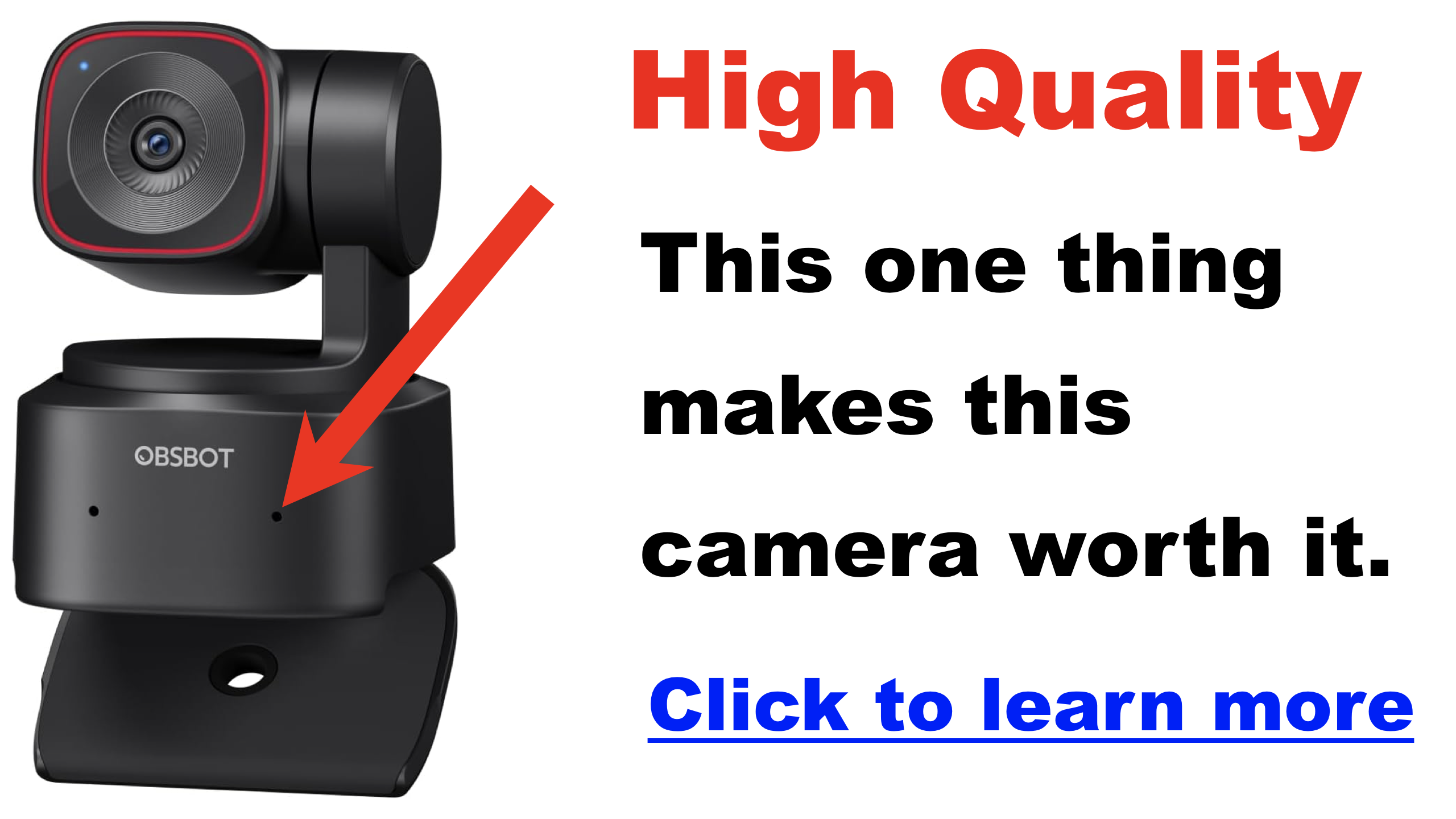The Ultimate Guide to Choosing Cameras and Lenses for Podcasting
Click to see our top camera pick
Why Your Camera Choice Matters in Podcasting
Video podcasts are on the rise, and for good reason. A high-quality video setup enhances audience engagement, boosts your brand’s professionalism, and opens doors to monetization. Choosing the right camera and lens will help create a polished, professional look that captures attention. In this guide, we’ll explore everything you need to know about cameras, lenses, and setups for podcasting success.
Podcasting Camera Types
Click here for my favorite all-around podcast camera
When selecting a camera for your podcast, it’s important to understand the pros and cons of each type. Your ideal choice depends on your podcasting style, content goals, and budget.
Webcams: Webcams are a go-to choice for beginners and anyone looking for a straightforward, reliable way to capture video. Many modern options offer impressive image quality, and some models include advanced features like motorized framing and face tracking. These tools can follow your movement or stay locked in place, depending on your setup and preference—perfect for podcasters who like to move around or want a dynamic, hands-free camera experience.
We have a few to look at in the table below. Be sure to check out the Elgato + the Osbot, which has awesome video quality for a “webcam” + has motor control + face tracking you can turn on and off so it will either follow you, or you can adjust it during a recording.
If you go the route of using a webcam to record your podcast, I highly recommend you look into a capture card for your computer. Capture card devices offload the work from the computer, and drastically increase the quality of the recording allowing you to capture crystal clear video. I highly recommend checking the Elgato brand out, they make some of the best hardware in the game. The HD60X is a great start.
- Pros: Affordable, easy to use, plug-and-play, minimal setup.
- Cons: Limited image quality, minimal control over settings, fixed lenses.
- Ideal for: Beginners, casual podcasters, streamers.
DSLR Cameras DSLRs provide flexibility and professional image quality, suitable for podcasters aiming for a polished look.
DSLRs crush webcams for podcasting because they offer larger sensors, superior low-light performance, and interchangeable lenses, giving you that crisp, cinematic look webcams simply can’t match. With pro-level autofocus, depth-of-field control, and external mic support, DSLRs provide the flexibility and quality needed to make your podcast stand out—whether you’re streaming live or recording in a studio setup.
The Canon 5D Mark IV is one of the best cameras on the market with 4K video — however DSLRs are known to have recording limits of about 30 minutes.
- Pros: Superior image quality, interchangeable lenses, depth-of-field control, versatility.
- Cons: Larger size, more expensive, additional equipment (like capture cards) needed for streaming, limited onboard recording.
- Ideal for: Professional-quality podcasts, interviews, detailed video.
Mirrorless Cameras Mirrorless cameras combine DSLR image quality with a smaller form factor, providing versatility and ease of use.
Mirrorless cameras can also deliver cinematic 4K video, razor-sharp autofocus, and pro-level low-light performance without the bulk of DSLRs. With silent operation, advanced eye-tracking, and direct USB streaming, they offer the perfect blend of portability and power, making them the go-to choice for podcasters who want a professional, high-quality look without the hassle.
The Canon EOS R5 Mark ii delivers cinematic 4K and 8K video, razor-sharp autofocus, and pro-level image quality that make podcast recordings look like a high-budget production.
- Pros: Excellent image quality, compact size, interchangeable lenses, good autofocus.
- Cons: Higher initial cost, battery life may vary, can require additional accessories for extended recording.
- Ideal for: Intermediate to advanced podcasters, content creators seeking high-quality visuals.
Action Cameras Action cameras are designed for durability and capturing dynamic or unconventional shots.
I would look into the latest GoPro offerings, the DJI Osmo, and the Insta360 — however please know that the quality of the video in a studio setting is generally not as good as a decent webcam.
- Pros: Compact, durable, versatile, great for dynamic and wide-angle shots.
- Cons: Limited zoom capability, generally not ideal for standard podcast formats.
- Ideal for: Outdoor podcasts, adventure-based or action-driven content.
Smartphone Cameras Smartphones today offer high-quality cameras suitable for beginners or budget-conscious podcasters.
Personal Story: I use an iPhone 15 Pro for almost everything I shoot because it is incredibly versatile, inexpensive when compared to DSLR options, and overall packs a huge punch with ability to record locally to a computer using OBS. While this setup isn’t for everyone, it is definitely a good option for most.
I highly suggest you watch the video below which talks about why they may be more than what you need to record or stream your podcast. Limitations are generally a flatter look, lighting requirements, and the battery draining faster than it can charge. While that is true when compared to much more expensive options; the iPhone has good depth of field, and overall has great color and clarity.
- Pros: Readily available, high-quality video recording, versatile and mobile.
- Cons: Limited control, fixed lenses, may require additional equipment for stability and quality.
- Ideal for: Budget-conscious podcasters and beginners testing video podcasts.
Find the Best Camera for Your Podcast
Click here for my favorite all-around podcast camera
| Camera Type | Model | Resolution | Best For | Notes |
|---|---|---|---|---|
| Webcam | Logitech C920x HD Pro | 1080p | Beginners, live-streaming | Affordable, plug-and-play simplicity. |
| Elgato Facecam | 1080p at 60fps | Streamers, high-quality streams | Low latency, great for streaming. | |
| Razer Kiyo Pro | 1080p at 60fps | Low-light environments | Built-in light adjustment. | |
| Logitech StreamCam | 1080p at 60fps | Content creators, portrait video | Portrait mode support for vertical content. | |
| DSLR | Canon EOS M50 Mark II | 4K (cropped) | Professional-quality podcasts | Great autofocus and flip-out screen. |
| Nikon D5600 | 1080p at 60fps | Sharper videos, flexibility | Excellent lens compatibility. | |
| Canon EOS Rebel T7 | 1080p at 30fps | Affordable DSLR setup | Beginner-friendly and reliable. | |
| Sony Alpha a6100 | 4K | Compact, high-quality videos | Amazing autofocus performance. | |
| Mirrorless | Sony ZV-E10 | 4K | Content creators, vlogging | Optimized for creators, interchangeable lenses. |
| Panasonic Lumix GH5 | 4K at 60fps | Advanced users, cinematic production | Exceptional video quality. | |
| Sony Alpha a6400 | 4K | Portable and versatile | Reliable, sharp results. | |
| Fujifilm X-T4 | 4K at 60fps | Color-rich, smooth footage | In-body stabilization is a bonus. | |
| Action Camera | GoPro Hero 13 Black | 5.3K at 60fps | Dynamic, wide-angle shots | Durable and versatile. |
| DJI Osmo Action 3 | 4K at 60fps | Compact and affordable | Great stabilization. | |
| Camcorder | Sony FDR-AX53 | 4K | Long recording sessions | Ideal for extended podcasts. |
| Canon Vixia HF G50 | 4K | Long sessions with simple setup | Easy to use for beginners. | |
| Smartphone | iPhone Pro Max | 4K at 60fps | Budget-friendly setups | Flagship phone with cinematic mode. |
| Samsung Galaxy S23 Ultra | 8K at 30fps | High-end detail and versatility | Outstanding video quality. |
Best Lenses That Make Your Podcast Shine
When setting up your podcasting studio for video recordings, the lens you select can dramatically affect your visual quality, aesthetics, and viewer engagement. Here’s a clear breakdown of the types of lenses to consider, their advantages and disadvantages, and practical recommendations tailored specifically for podcasting studios.
Types of Lenses to Consider:
1. Prime Lenses
Prime lenses have a fixed focal length (e.g., 35mm, 50mm, 85mm) and typically offer superior image quality and wider apertures (f/1.8, f/1.4, or f/1.2).
Pros:
- Excellent image sharpness and clarity.
- Great in low-light conditions due to wide apertures.
- Beautiful background blur (bokeh) helps focus viewers on the subject.
Cons:
- Limited flexibility; requires physical repositioning of the camera to change framing.
Recommended Primes for Podcast Studios:
- Sony FE 50mm f/1.8: Versatile, affordable, and great for portrait-style framing.
- Canon RF 85mm f/2 Macro: Ideal for tighter headshots with stunning clarity.
2. Zoom Lenses
Zoom lenses allow varying focal lengths within one lens (e.g., 24-70mm, 70-200mm), providing versatility in framing without moving the camera.
Pros:
- Highly versatile; quickly switch framing between wide, medium, and close-up shots.
- Ideal for multi-camera setups or dynamic podcast formats.
Cons:
- Slightly less sharp than prime lenses.
- Usually heavier and more expensive.
Recommended Zooms for Podcast Studios:
- Sigma 24-70mm f/2.8 DG DN: Excellent image quality, highly versatile for various studio setups.
- Tamron 28-75mm f/2.8: Cost-effective, sharp optics, and great value for money.
3. Wide-Angle Lenses
Wide-angle lenses (e.g., 16mm, 24mm) capture broader scenes and are excellent for showing off a podcast studio space or accommodating multiple hosts.
Pros:
- Great for group podcasts or studio tours.
- Provides engaging perspectives and dynamic visuals.
Cons:
- Potential distortion if subjects are too close to the camera.
- Less effective for close-up, intimate visuals.
Recommended Wide-Angles for Podcast Studios:
- Sony FE 20mm f/1.8 G: Outstanding optical quality with minimal distortion.
- Canon RF 16mm f/2.8: Compact and affordable; great for small spaces.
Choosing the Right Lens for Your Needs:
- Portrait-Focused Podcasts: Prime lenses like the 50mm or 85mm give superior sharpness and beautiful backgrounds, ideal for single-host or interview formats.
- Dynamic, Multi-Angle Podcasts: Zoom lenses such as 24-70mm offer framing flexibility, essential for quickly adjusting compositions.
- Group or Panel Podcasts: Wide-angle lenses effectively capture everyone clearly and give viewers a sense of your studio environment.
Tips for Podcast Studio Lens Setup:
- Consider the space available: smaller rooms might benefit from wider lenses (20-35mm).
- Prioritize aperture: lenses with f/2.8 or wider ensure excellent low-light performance and professional background blur.
- Balance cost and quality: Invest in a high-quality prime or zoom lens for your primary camera, supplementing with affordable lenses for secondary angles.
| Lens Type | Focal Length (Aperture) | Best For | Notes |
|---|---|---|---|
| Prime | 35mm (f/1.8 or f/1.4) | Medium-wide shots, small spaces | Natural perspective, versatile. |
| 50mm (f/1.8 or f/1.4) | Head-and-shoulder shots | Classic framing, beautiful depth of field. | |
| 85mm (f/1.8) | Close-ups with blurred backgrounds | Ideal for interviews and isolation shots. | |
| Wide-Angle | 24mm (f/2.8) | Group shots, tight spaces | Wider framing without distortion. |
| 18mm (f/2.8) | Multi-host setups in small rooms | Ultra-wide view, perfect for tight spaces. | |
| Zoom | 24-70mm (f/2.8) | Versatile for varied setups | Covers wide, mid, and close framing. |
| 18-55mm (f/3.5-5.6) | Budget-friendly multi-use lens | Affordable and flexible. | |
| 70-200mm (f/2.8) | High-quality close-ups in larger spaces | Stunning compression and sharpness. | |
| Macro/Specialty | 100mm Macro (f/2.8) | Close-ups of products or details | Extremely sharp for close-up shots. |
| 11-16mm (f/2.8) | Ultra-wide, creative shots | Captures the entire setup. |
Click for Lens Options at a Glance
How to Set Up Multiple Cameras for Your Podcast
Adding multiple camera angles can elevate your podcast by making it more dynamic and engaging. Here’s how to create a multi-camera setup:
Why Go Multi-Camera?
Switching between angles keeps your audience engaged and provides flexibility in post-production. You can highlight individual hosts, showcase reactions, or capture wide shots of the entire setup.
Essential Tools for Multi-Camera Setups
| Equipment | Purpose |
|---|---|
| Cameras | Matching models ensure consistent quality. |
| Capture Cards | Connect cameras to your computer (e.g., Elgato Cam Link). |
| Video Switchers | For live switching between feeds (e.g., ATEM Mini). |
| Lighting | Ensures consistent exposure for all angles. |
| Tripods/Mounts | Keeps cameras stable at the right angles. |
| Audio Recorder | High-quality audio recording (e.g., Zoom H6). |
Wrapping It All Up
The right camera and lens can transform your podcast into a visual experience that captivates your audience. But without great podcast lighting, you’ll be shooting in the dark! Be sure to have a good studio set up with great audio gear too. Whether you’re working with a single camera or a multi-camera setup, the key is to choose tools that match your goals and budget. With the tips and recommendations in this guide, you’re well on your way to creating a standout video podcast.
🚀 Want to Turn Your Podcast Into a Money-Making Machine?
Most podcasters never figure out how to make real money from their show. Don’t be one of them. Click here to learn why your podcast needs a website immediately.
📈 Steal the exact playbook top podcasters use to turn listeners into cash.
🎥 FREE video training reveals the monetization secrets nobody is telling you.
📩 Stop guessing. Start making. Drop your email & get the guide for free.




